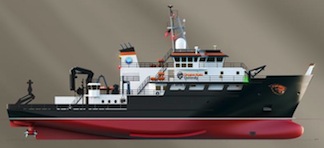The following is text of news releases from Gulf Island Fabrication Inc. and Oregon State University:
(HOUSTON) — Gulf Island Shipyards has been awarded a contract by Oregon State University for the construction of a regional class research vessel (RCRV) with an option for two additional vessels.
The state-of-the-art 193-foot ships will be highly flexible, multi-mission platforms that maximize energy efficient design concepts. The vessels will be ABS Ice class C0 and DPS-1, Green Marine certified, acoustically quiet, and carry up to 29 crew and embarked scientists.
“As we continue to explore areas outside our traditional sectors, we are excited to obtain this important project and we look forward to working closely with Oregon State University as they explore ways to enhance our environment for our way of life and for future generations beyond,” stated Kirk J. Meche, president and CEO of Gulf Island Fabrication Inc.
"OSU is excited to work with Gulf Island Shipyards to deliver the nation's newest class of oceanographic research ships to the National Science Foundation and the ocean science community. Gulf Island's reputation for quality work and customer service are a perfect fit for this important project," said Dr. Roberta Marinelli, dean of OSU's College of Earth, Ocean, and Atmospheric Sciences.
Oregon State University received a grant of $121.88 million from the National Science Foundation to spearhead the construction of the research vessels. It is the largest grant in the university’s history.
When funding for the next two vessels is authorized, the total grant to OSU could increase to as much as $365 million. The first vessel is slated to be operated by OSU for research missions focusing on the U.S. West Coast. The NSF will begin the competitive selection of operating institutions for the second and third vessels later this year – likely to universities or consortia for operations on the U.S. East Coast and the Gulf of Mexico.
Officials hope to have a keel-laying ceremony for the first vessel in the spring of 2018, with the ship delivered to OSU for a year of extensive testing in 2020.
The ships will be equipped to conduct detailed seafloor mapping, to reveal geologic structures important to understanding processes such as subduction zone earthquakes that may trigger tsunamis. The Pacific Northwest is considered a high-risk region because of the Cascadia Subduction Zone, which has produced about two dozen major earthquakes of magnitude 8.0 or greater over the past 10,000 years.
The new ships will also be equipped with advanced sensors that will be used to detect and characterize harmful algal blooms, changing ocean chemistry, and the interactions between the sea and atmosphere. The emerging fields of wave, tidal and wind energy will benefit from ship observations. Oregon State is the site of the Northwest National Marine Renewable Energy Center, which in December was awarded a grant of up to $35 million from the U.S. Department of Energy to create the world’s premier wave energy test facility in Newport.
Some characteristics of the new regional class research vessels (RCRVs):
193 feet long with a 41-foot beam;
Range of approximately 7,000 nautical miles;
Cruising speed is 11.5 knots with a maximum speed of 13 knots;
16 berths for scientists and 13 for crewmembers;
Ability to stay out at sea for at least 21 days before returning to port;
High bandwidth satellite communications for streaming data and video to shore.
OSU previously operated the 184-foot R/V Wecoma from 1975 until 2012, when it was retired. The university then assumed operations of Wecoma’s sister ship, R/V Oceanus, from Woods Hole Oceanographic Institution; that ship will be retired when the new ship is ready.
The tentative timetable for the new ships:
Ship No. 1 keel laying – spring 2018;
Ship No. 1 transition to OSU for a year of testing – fall 2020;
Ship No. 1 should be fully tested, have UNOLS designation and be fully operational by fall 2021;
Ship No. 2 – Keel laying in winter of 2018, delivery in spring 2021, and UNOLS designation in late spring 2022;
Ship No. 3 – Keel laying in fall 2020, delivery in spring 2022, and UNOLS designation in spring 2023.
More information on the ships and the project is available at: http://ceoas.oregonstate.edu/ships/rcrv/.

